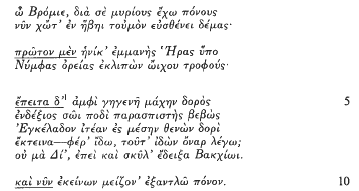Research Article
The wounds in Iliad 13–16*
-
- Published online by Cambridge University Press:
- 11 February 2009, pp. 345-363
-
- Article
- Export citation
The invention of Homer
-
- Published online by Cambridge University Press:
- 11 February 2009, pp. 364-382
-
- Article
- Export citation
To praise, not to bury: Simonides fr. 531P
-
- Published online by Cambridge University Press:
- 11 February 2009, pp. 383-395
-
- Article
- Export citation
The serpent and the sparrows: Homer and the parodos of Aeschylus’ Agamemnon
-
- Published online by Cambridge University Press:
- 11 February 2009, pp. 396-407
-
- Article
- Export citation
Further critical notes on Euripides' Hippolytus
-
- Published online by Cambridge University Press:
- 11 February 2009, pp. 408-427
-
- Article
- Export citation
Comic priamel and hyperbole in Euripides, Cyclops 1–10
-
- Published online by Cambridge University Press:
- 11 February 2009, pp. 428-432
-
- Article
- Export citation
Some observations on the Persae of Timotheus (PMG 791)*
-
- Published online by Cambridge University Press:
- 11 February 2009, pp. 433-438
-
- Article
- Export citation
Thucydides 5.26.3–5: the verb ἰσχυρίζεσθαι and a contrast in methodology*
-
- Published online by Cambridge University Press:
- 11 February 2009, pp. 439-444
-
- Article
- Export citation
The Cyclops of Philoxenus
-
- Published online by Cambridge University Press:
- 11 February 2009, pp. 445-455
-
- Article
- Export citation
Addendum
Addendum
-
- Published online by Cambridge University Press:
- 11 February 2009, p. 455
-
- Article
- Export citation
Research Article
Conditional irony in the Socratic dialogues
-
- Published online by Cambridge University Press:
- 11 February 2009, pp. 456-472
-
- Article
- Export citation
The death of Cyrus the Younger
-
- Published online by Cambridge University Press:
- 11 February 2009, pp. 473-483
-
- Article
-
- You have access
- Export citation
The Attic Genos
-
- Published online by Cambridge University Press:
- 11 February 2009, pp. 484-489
-
- Article
- Export citation
On Sterility (‘HA X’), a medical work by Aristotle?
-
- Published online by Cambridge University Press:
- 11 February 2009, pp. 490-502
-
- Article
- Export citation
Hooking in harbours: Dioscurides XIII Gow-Page
-
- Published online by Cambridge University Press:
- 11 February 2009, pp. 503-514
-
- Article
- Export citation
Greek embryological calendars and a fragment from the lost work of Damastes, On the Care of Pregnant Women and of Infants
-
- Published online by Cambridge University Press:
- 11 February 2009, pp. 515-534
-
- Article
- Export citation
Jerome's dates for Gaius Lucilius, satyrarum scriptor*
-
- Published online by Cambridge University Press:
- 11 February 2009, pp. 535-543
-
- Article
- Export citation
Drusus and the spolia opima
-
- Published online by Cambridge University Press:
- 11 February 2009, pp. 544-555
-
- Article
- Export citation
Agriculture, underemployment, and the cost of rural labour in the Roman world
-
- Published online by Cambridge University Press:
- 11 February 2009, pp. 556-572
-
- Article
- Export citation
Ausonius’ Fasti and Caesares revisited
-
- Published online by Cambridge University Press:
- 11 February 2009, pp. 573-578
-
- Article
- Export citation


